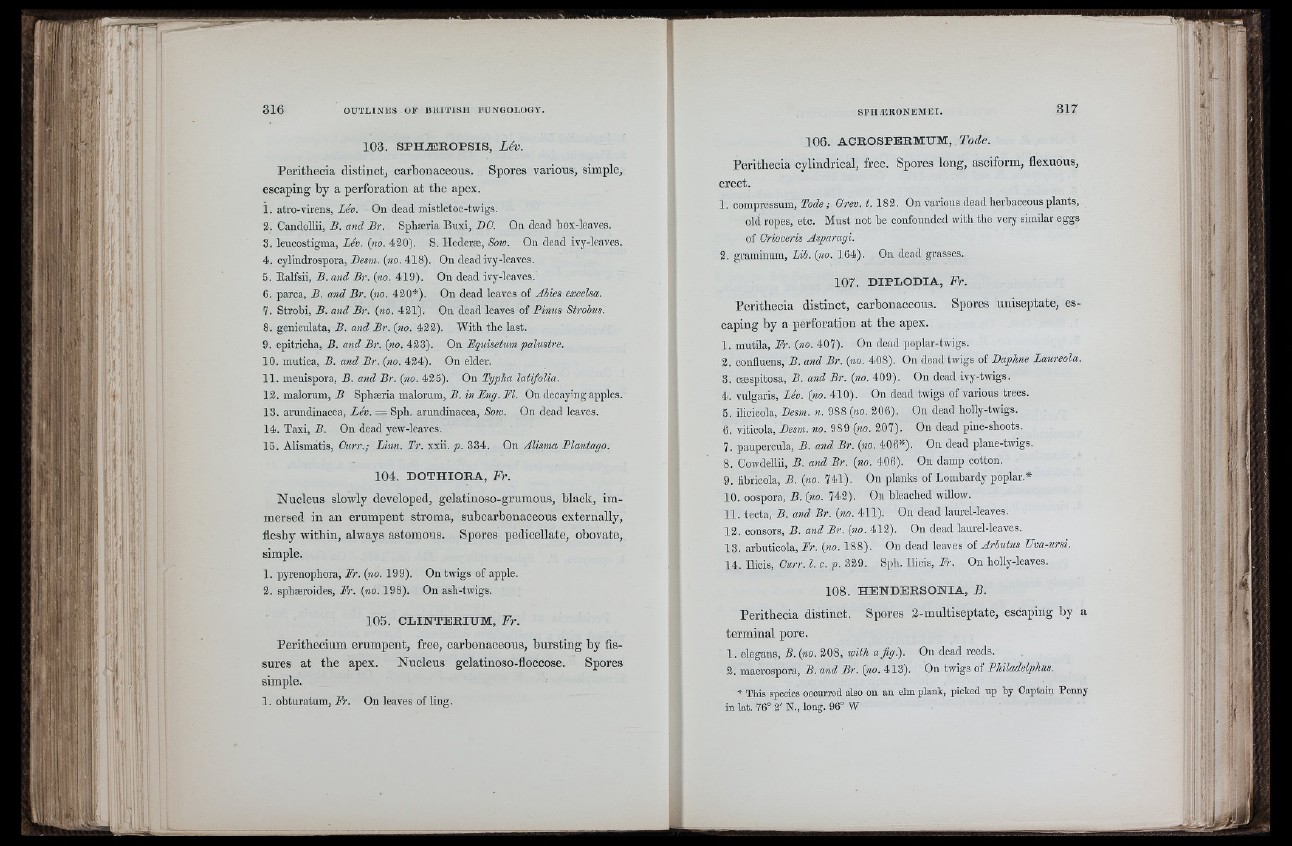
A/',}
Î.Ï I
| | | |
i! -!iS
dUllfl
103. SPHÆROPSIS, Lèv.
Perithecia distinct, carbonaceous. Spores various, simple,
escaping by a perforation at the apex.
1. atro-virens, lèv. On dead mistletoe-twigs.
2. Candollii, B. and Br. Sphæria Biixi, DO. On dead box-leaves.
3. leucostigma, Lèv. {no. 420). S. Hederæ, Soio. On dead ivy-leaves.
4. cylindrospora, Desm. {no. 418). On dead ivy-leaves.
5. Ealfsii, B. and Br. {no. 419). On dead ivy-leaves.
6. parca, B. and Br. {no. 420*). On dead leaves of Abies excelsa.
7. Strobi, B. and Br. {no. 421). On dead leaves of Pinus Strobus.
8. geniculata, B. and Br. {no. 422). With the last.
9. epitricha, B. and Br. {no. 423). On Equisetum palustre.
10. inutica, B. and Br. {no. 424). On elder.
11. menispora, B. and Br. {no. 425). On Typha latifolia.
12. maloruin, B Sphæria malorum, B. in Eng. El. On decaying apples.
13. arundinacea, Lèv. = Sph. arundinacea, Sow. On dead leaves.
14. Taxi, B. On dead yew-leaves.
15. Alismatis, Ourr.; Linn. Tr. xxii. p. 334. On Alisma Plantago.
104. DOTHIOEA, Fr.
Nucleus slowly developed, gelatinoso-grumous, black, immersed
in an erumpent stroma, suhcarhonaceous externally,
fleshy within, always astomous. Spores pedicellate, obovate,
simple.
1. pyrenophora, Pr. {no. 199). On twigs of apple.
2. sphæroides, Tr. {no. 198). On ash-twigs.
105. CLINTERIUM, Fr.
Perithecium erumpent, free, carbonaceous, bursting by fissures
at the apex. Nucleus gelatinoso-floccose. Spores
simple.
106. ACROSPERMUM, Tode.
Perithecia cylindrical, free. Spores long, asciform, flexuous,
erect.
1. compressum, Tode; Grev. t. 182. On various dead herbaceous plants,
old ropes, etc. Must not be confounded with the very similar eggs
of Orioceris Asparagi.
2. graminum. Lib. {no. 164). On dead grasses.
107. DIPLODIA, Fr.
Perithecia distinct, carbonaceous. Spores uniseptate, escaping
by a perforation at the apex.
1. mutila, Fr. {no. 407). On dead poplar-twigs.
2. conilnens, B. and Br. {no. 408), On dead twigs of Daphne Laureola.
3. csespitosa, B. and Br. {no. 409). On dead ivy-twigs.
4. vulgaris. Lev. {no. 410). On dead twigs of various trees.
5. ilicicola, Desm. n. 988 {no. 206). On dead holly-twigs.
6. viticola, Desm. no. 989 {no. 207). On dead pine-shoots.
7. paupercula, B. and Br. {no. 406*). On dead plane-twigs.
8. Cowdellii, B. and Br. {no. 406). On damp cotton.
9. fibricola, B. {no. 741). On planks of Lombardy poplar.*
10. oospora, B. {no. 742). On bleached willow.
11. tecta, A, «»¿-Br. («0. 411). On dead laurel-leaves.
12. consors, B. and Br. {no. 412). On dead laurel-leaves.
13. arbuticola, Fr. {no. 188). On dead leaves of Arbutus Uva-ursi.
14. Ilicis, Curr. I. c. p. 329. Sph. Ilieis, Fr. On holly-leaves.
108. HENDERSONIA, B.
Perithecia distinct. Spores 2-multiseptate, escaping by a
terminal pore.
1. elegans, B. {no. 208, with a fig.). On dead reeds.
2. macrospora, B. and Br. {no. 413). On twigs of Philadelplms.
* This species occurred also on an elm plank, picked up by Captain Penny
in lat. 76“ 2' N., long. 96“ W
fi llj
'; 'lIl
Ij!
i v